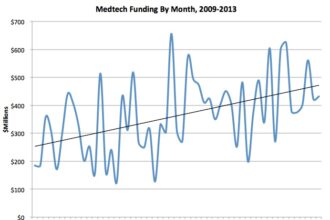
Originally published on MedCityNews.com.

Originally published on MedCityNews.com.
Mainstream consumer health doesn’t need Apple. There are new self-tracking apps and devices being devised every day to satisfy even the most hardcore quantified selfer.
The issue isn’t that there aren’t enough devices in the market; it’s that not many people are using them. That’s why Apple is well-poised to succeed if it wades into that crowded territory, as rumors have led us to believe it will.
Apple’s staying mum on exactly what the rumored “iWatch” would do, but recent hiring moves, patents and hints from CEO Tim Cook suggest it could include some of the features of the iPhone and iPod along with biometric sensing capabilities.
The company inherently has some advantages over the FitBits and Jawbones of the world that would serve it well in the wellness-oriented wearables space. One of the most appealing thoughts about an Apple product from the health and wellness angle is the idea of a wearable platform device. Apple has driven some of its value from the millions of apps external developers create for its mobile devices and make available through the App Store. (In the same breath, the lack of apps has been one of the early criticisms of competitor Microsoft’s Surface tablet).
Meanwhile, in the wearables market, a handful of smaller companies have raised millions of dollars to essentially re-invent the wheel. Each device looks and works a little bit differently, but at their core, aren’t they mostly doing the same thing? As a user, it would be nice to see Apple package the key components – an accelerometer, heart rate monitor, skin sensor – in an attractive device and let app developers dream up different ways to digest the data they produce.
Let’s not fly past that attractive packaging point. Wrist-worn trackers may be convenient, but they’ve also been criticized for being clunky, ugly or lacking a display screen. Apple’s thin, simple and sleek design principles lend themselves well to taking the shape of a watch. When I first saw the Misfit Shine, which has been praised for its design, I actually thought it looked like something inspired by Apple (maybe Misfit co-founder and ex-Apple CEO John Sculley had something to do with that). Check out this 9to5Mac post that rounds up some interesting designs readers and users have come up with.
The tech company’s focus on user experience doesn’t hurt, either. Even without a specific health-focused device, Apple is one of the dominant brands in the medical world because of its usability, durability and versatility. As a testament to that, look at how the diabetes community has been wishing for more “Apple-esque” medical devices for more than five years now. The brains behind the devices also seem to have a knack for coming up with intuitive features we didn’t know we wanted until they give them to us. I never thought it particularly inconvenient to push buttons on a cell phone, for example, until seeing I could push one button and tell the phone what to do.
Perhaps most importantly, Apple’s got the reputation, the religious following and the marketing chops to make it work in consumer health. Granted, Nike’s Fuelband has the brand, too, and it is one of the more popular devices on the market. But what it’s missing in some of its basic tracking features, Apple could probably tackle.
As one last wish, can one of those features be embedded GPS, so we runners can stop wearing those unsightly GPS watches?








